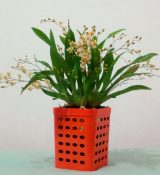Orchid Propagation – Seeds
Author: adminNo Comments
Blooming, Care and Culture, Propagation
Orchid seeds are extremely minute. Each consists of only a tiny embryo surrounded by a single layer of protective cells. They are so small that the food reserves in the embryo are inadequate, by themselves, for the early development of the new plant.
In nature most orchid seeds begin life in a partnership with a symbiotic fungus. The fungal hyphae; which are present in the soil or on the bark of a host tree, invade the seed and enter the cells of the embryo. The orchid soon begins to digest the fungal tissue and obtain nutrients form it, thus using the fungus as an intermediary in obtaining nutrients from decaying material in the soil.
In the laboratory this process can be imitated by sowing sterilized seeds with a culture of the fungus on a suitable jelly-like medium called agar with the addition of porridge oats which the fungus can utilize. A simpler method is to use a medium containing all the mineral nutrients, water and sugar that the germinating seed needs and dispense with the fungus. All these techniques must be carried out in sterile conditions – otherwise it is extremely easy for the nutrient medium to become infected with unwanted micro-organisms that develop at the expense of the orchid. The work can be carried out in the kitchen, using a domestic pressure cooker to sterilize the greenhouse and growing media. A sterile box or even a large polythene bag can be used as a cover for the operation which should be carried out as speedily as possible. However, the technique is more easily successfully performed in a specialized laboratory on a laminar flow bench.
Conical flasks, petri dishes or sterile bottles containing the newly sown seeds are kept under controlled conditions while the embryo grows out through the seed-coat to form, first, a rounded protocorm covered in rhizoids and then a small plantlet. Sometimes the containers need to be kept in the dark for the first few months, but the epiphytic orchids develop green protocorms almost immediately and are kept under artificial light for 12-16 hours per day. Although the flasks are sealed, the medium becomes too solid through dehydration after a few months, and the plantlets need to be transferred to freshly prepared medium in a new containerl. These techniques must also be carried out under sterile conditions. Eventually, about six to twelve months after sowing, the plantlets are large enough to be taken out of the flask, washed carefully to remove all traces of agar, and then potted up in a fine compost mix. For their first few weeks in the greenhouse they need special care. Extra warmth and humidity, as can be provided in a small propagating case, is often beneficial.
Different kinds of orchids develop at different rates. Some of the quickest are the Phalaenopsis species and hybrids which can grow from seeds to flowering size in as little as 18-20 months. Others take much longer. Four to six years is an average length of time for most orchids.


Ask an Expert
Questions about orchids?
Our experts love a challenge!
Photo of the Week
Submit your photo to be featured on the blog!
More Photo of the Week Winners
Submit Photo







